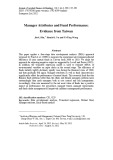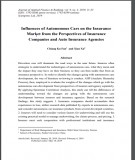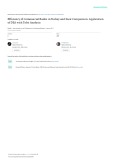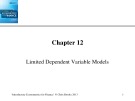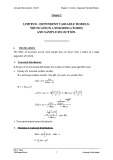
Truncated regression model
-
This paper applies a four-stage data envelopment analysis (DEA) approach proposed by Fried et al. (1999) to measure the operational environment-adjusted efficiency of sixty mutual funds in Taiwan from 2006 to 2010. We adopt the approach for adjusting negative output as suggested by Lovell and Pastor (1995). In addition, the truncated regression model is used to estimate effects of environmental variables on input slacks in the second stage. The efficiency of funds initially lightly declined, rapidly rose during the financial crisis of 2008, and then gradually fell again.
 17p
17p  nguyenminhlong19
nguyenminhlong19
 21-04-2020
21-04-2020
 20
20
 3
3
 Download
Download
-
Using 2009–2017 Taiwanese insurance company data from the database of Taiwan Economic Journal, we employ Simar–Wilson bootstrapping to prevent efficiency overestimation in data envelopment analysis (DEA) and then regress the factors on these efficiency scores by using a truncated rather than traditional Tobit model. Evidence shows that the companies’ modified average efficiency score is 0.8784 (0.9068 using DEA). Meanwhile, domestic insurers outperform foreign insurers, and larger companies perform more poorly.
 1p
1p  chauchaungayxua2
chauchaungayxua2
 19-01-2020
19-01-2020
 31
31
 1
1
 Download
Download
-
This paper aims to investigate the technical and allocative efficiency scores of 23 commercial banks operating in Turkey between 2003 and 2012 by using data envelopment analysis (DEA). In the CCR model analysis, the number of technically inefficient banks rises from three to six and the number of allocatively inefficient banks falls from six to five within the given period. On the other hand the number of technically efficient banks falls from 22 to 19 whereas the number of allocatively efficient banks rises from 10 to 16 in the study period according to BCC model analysis.
 21p
21p  chauchaungayxua2
chauchaungayxua2
 04-01-2020
04-01-2020
 23
23
 2
2
 Download
Download
-
Chapter 12 - Limited dependent variable models. In this chapter, you will learn how to: Compare between different types of limited dependent variables and select the appropriate model, interpret and evaluate logit and probit models, distinguish between the binomial and multinomial cases, deal appropriately with censored and truncated dependent variables, estimate limited dependent variable models using maximum likelihood in EViews.
 49p
49p  estupendo3
estupendo3
 18-08-2016
18-08-2016
 50
50
 2
2
 Download
Download
-
Lecture "Advanced Econometrics (Part II) - Chapter 5: Limited dependent variable models - Truncation, censoring (tobit) and sample selection" presentation of content: Truncation, censored data, some issues in specification, sample selection model, regression analysis of treatment effects.
 13p
13p  nghe123
nghe123
 06-05-2016
06-05-2016
 61
61
 4
4
 Download
Download
CHỦ ĐỀ BẠN MUỐN TÌM








